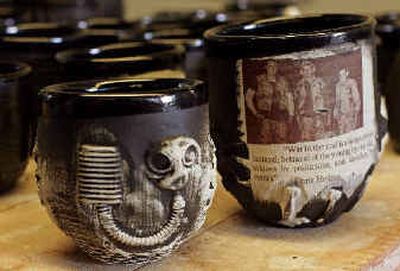The Art of War

BERKELEY, Calif. – Ehren Tool never fired a gun in the Persian Gulf War. When his Marine buddies went trophy hunting in the trenches, he stayed put, warned by his Vietnam veteran dad not to seek out the naked face of war.
And yet there are things he can’t forget: the danger, the urgency, the revelation that life can be lost between the tick and the tock of a moment.
“I feel like there’s this siren all the time, and everybody’s just walking along normal, nobody’s breaking for the fire exits,” he says.
The feeling drives him to slap another lump of clay on his potter’s wheel and set it spinning, coaxing the chocolatey brown mass into small cups that appear innocuous at first glance, but then quite disturbing – stamped with bombs, skulls, gas masks and the U.S. Marine Corps insignia.
Artists have long been inspired by war. Many of the most famous pieces were created by civilians, such as Pablo Picasso and his “Guernica,” depicting the horrors of the bombing of a village in the Spanish civil war.
But there is something particularly compelling about art created by the soldiers themselves.
Jerry Kykisz, general manager of the National Vietnam Veterans Art Museum in Chicago, says a combination of things seems to inspire the collection, which comes from people who served on all sides of that war.
“A lot of the art is what you would call conflicted,” he says. “There’s certainly anger. There’s certainly other expressions. Most people who were in a combat situation find there is that overwhelming response to a situation that they need to get out, and sometimes that emotional response is conflicted.”
Michael Aschenbrenner, a glass artist and Vietnam vet who permanently injured his knee when he dislocated it jumping out of a helicopter – and then had to walk on it for two days – turned his experiences directly into art. His “Damaged Bones” is a series of sculptures held together by splints or other materials that demonstrates the fragility of life.
Aschenbrenner, like Tool, began his war-inspired art with ceramics.
“I think everybody starts trying to figure out who they were before they went,” he says. “I don’t think you ever return as that person.”
Tool recalls being mildly interested in art before going to war, although he never intended to make it his career. When he came back, he enrolled in college on the GI Bill, planning to become an EMT. But the drawing and painting classes for which he signed up began to appeal, especially after he injured his ankle.
This May, Tool expects to graduate with a Masters of Fine Art degree from the University of California at Berkeley. Where he goes from there, he has no idea.
So far, he’s made little money from his work, perhaps because he’s uneasy with the idea of profiting from war. He estimates that he’s given away more than 4,000 cups in the last four years. Some have gone to homeless people, some to friends, many to Marines.
One cup, about the right size for an espresso, is rimmed by a gleaming ribbon of black glaze and has interesting bulges on the side and base. Close up, the indentations are revealed as a series of bombs interspersed with the U.S. Marine Corps insignia. On the bottom, sandbags are piled around a skull and crossbones.
Some of the decorations are made with real items, such as medals. Others, from bombs to gas masks, were made using the vast array of war toys available.
Tool picked cups as a way to talk about war in a nonthreatening way.
“I can put the most horrible, graphic image on a cup and it’s still just a cup,” he says. “So much of the war art is so absolute. It’s, ‘This is a horrible thing and so wrong. We’ve got to stop it.’ But part of the thing with the cups is we are just so much more involved in the military than we admit.”
One of Tool’s cups has a picture of himself and two other Marines from the 1991 war on one side. On the other side is a picture of three strangers, troops from the current war in Iraq.
The second picture “freaks me out,” Tool says. “I thought I was a big man, doing big important things. That’s me and two friends. And these are three other dudes in the war now. Just random guys. And they look like … kids.”
For a piece called “393,” memorializing U.S. troops killed in action during the first year of the current war, Tool produced that many cups, shot each one with a pellet gun and displayed the broken fragments of the cups in front of a screen playing a videotape of the shooting.
His work, which has been shown at UC Berkeley’s Worth Ryder Gallery as well as at California State University, Long Beach, also includes a “Letter” project, in which he sent cups and letters to more than 50 government officials and other leaders.
Tool considers his work neither pro- nor anti-war. “War,” he says, “just is.
“I just want to talk about it,” he adds. “I just want you, as you’re strolling through the sunny countryside, to think about a land mine or a sandbag or a bomb, to think about how lucky you are.”